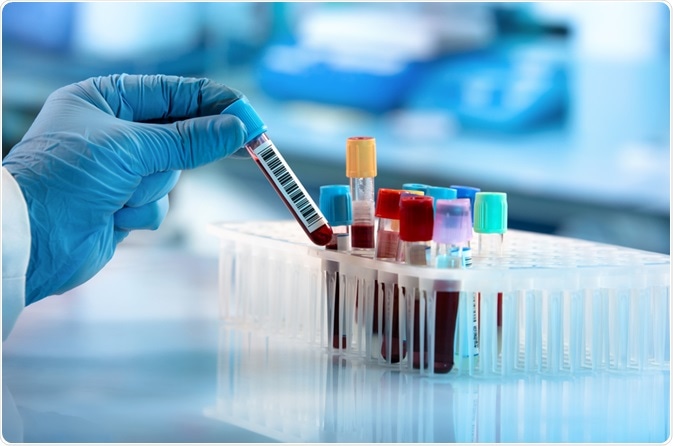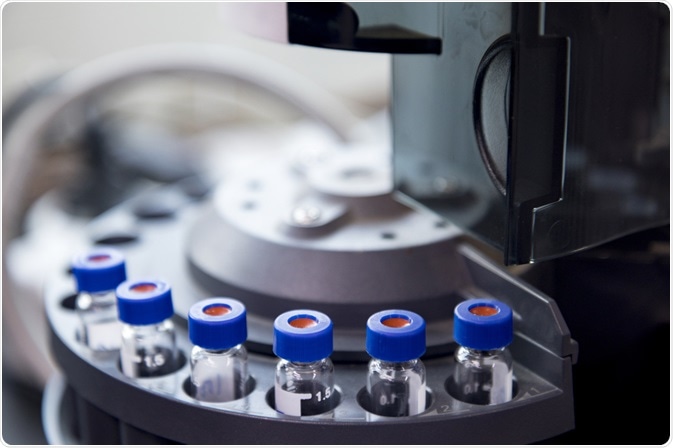Blood is one of the most frequent biological specimens, alongside urine and tissue, used in forensic toxicology to examine cases such as recent drug ingestion, driving under influence, the effects of a drug on a human body, and the probable cause of death.

Image Credit: angellodeco/Shutterstock.com
In addition, blood can reveal exposure of the drugs within the last hours to days of consumption and is relatively homogenous for a precise analysis. To study cases involving drug abuse, toxicologists perform certain procedures for detecting, screening, and quantifying the drug concentrations with other toxicants in the blood.
The Scientific Working Group for the Analysis of Seized Drugs (SWGDRUG) has confirmed some methods that are effective for quantitative drug testing, such as one with the highest discriminatory; mass spectroscopy. Especially with the growing needs for the analysis of drugs due to the increasing DUID, developments in drug analysis are essential in forensic toxicology laboratories.
Collection of Blood Specimen for Testing
The collection of blood differs between living and deceased individuals. The obtention of blood from living individuals must be performed by medical technicians, nurses, or licensed physicians. Alcohol must not be involved in the cleaning of the collection site for living individuals when collecting a blood sample.
Gray-topped tubes consisting of the chemicals sodium fluoride to preserve the blood and potassium oxalate to prevent blood clotting, or purple EDTA tubes are required to collect approximately fifteen to twenty milliliters of the sample. The tubes are then inverted to mix the additives and the blood. The appropriate labeling is usually placed and the tubes, as well as proximal containers, are tightly sealed to prevent openings by unauthorized individuals.
While collecting specimens from the deceased requires a warrant of autopsy and follows a set of tiers listed, where specimens are classified into three tiers of importance. Blood, alongside urine, eye fluid, and peripheral blood specimens, are grouped in tier one as the primary specimens.
As blood from the heart is commonly abundant and accessible, the heart becomes a favorable site to collect blood from. The blood sample with a minimum of 20 milliliters in volume is usually stored in gray-lidded tubes. In addition, the blood collected from a peripheral site can be complementary to the cardiac blood due to postmortem redistribution occurring.
Drug Screening Tests
Once the blood specimens are collected, it is screened for specific drug classes through immunoassay methods. Cutoffs set by regulatory bodies help classify samples into negative and nonnegative, at which the value equal to or greater than the cutoff measurement is deemed "nonnegative.”
Confirmatory testing will then be performed on those samples with nonnegative results through acquiring an aliquot from the sample, while samples with screening tests resulting negative would not undergo any further testing. The chemical substances that are detected during screening are isolated from the biological matrix liquid for confirmatory testing purposes.
The appropriate solvents, such as acetone or acetonitrile, are then introduced to the biological fluid to precipitate protein alongside unwanted chemical components. The analyte is concentrated by the process of filtration and extraction before performing further confirmatory testing with various analytical techniques.
Applying DART to drug screening.

Image Credit: kdsoo322/Shutterstock.com
Mass spectrometry provides the highest discriminatory technique
Mass spectrometry provides a sensitive technique for drug testing, as the compound of interest can be detected as low as the attomolar range and coupling mass spectrometry with a chromatography can determine almost any drug compound.
Mass spectrometry serves drug testing through obtaining valuable information, such as the abundance of elemental isotopes and the molecular mass of the chemical components involved. Sample preparation for blood analysis may include solid-phase, liquid-liquid, or supported liquid extraction.
Drugs like anesthetics, sedative-hypnotics, and narcotics can usually be analyzed by GC-MS in both clinical and forensic toxicology laboratories. In addition, the technique is useful for the detection of alcohol as volatile compounds in blood. However, limitations of using this technique exist; most mass spectrometry techniques are destructive and hazardous consumables may increase the cost of drug testing through this particular technique.
Some forensic toxicology laboratories have replaced GC-MS with LC-MS for its ability to analyze non-volatile molecules, alongside its less time-consuming technique than GC-MS. LC-MS also provides a more fitting analysis of morphine glucuronides, which is an exception analysis for using the GC-MS technique.
Furthermore, since biotransformation occurs with drugs in the body due to the metabolic reactions of phase I and phase II, LC-MS becomes a more efficient technique for the state of the metabolites, mainly from phase II metabolites. LC-MS utilizes electrospray ionization to analyze non-volatile compounds by generating ions from a liquid into the mass spectrometer.
Nevertheless, the LC-MS technique can be more expensive than GC-MS and the use of inter-laboratory comparisons are not available for identifying the chemical compounds detected. Through chromatographic techniques and their sensitivities, along with how the samples are prepared, more substances can accurately be identified in blood specimens.
References:
- Harper, L., et al. (2017). An overview of forensic drug testing methods and their suitability for harm reduction point-of-care services. Harm Reduction Journal, 14(1), doi: 10.1186/s12954-017-0179-5
- Issa, S. Y. (2019). ‘Forensic toxicology’, in Karcioglu, O. (ed.) Poisoning in the Modern World - New Tricks for an Old Dog? London: Intech, pp. 534-555.
- Mbughuni, M. M., et al. (2016). Mass spectrometry applications for toxicology. Journal of the International Federation of Clinical Chemistry and Laboratory Medicine, 27(4), pp. 272-287, PMID 28149262
- Moeller, M., and Kraemer, T. (2002). Drugs of Abuse Monitoring in Blood for Control of Driving Under the Influence of Drugs. Therapeutic Drug Monitoring, 24(2), pp.210-221, doi: 10.1097/00007691-200204000-00003
- Schimel, B., 2020. Physical Evidence Handbook. 9th ed. Wisconsin: State of Wisconsin Department of Justice.
- Thermo Fisher Scientific. n.d. Forensic Blood Analysis. [Online] Available at https://www.thermofisher.com/us/en/home/industrial/forensics/forensics-learning-center/forensic-drug-testing-information/suitable-samples-drug-testing/forensic-blood-analysis.html (Accessed 9 August 2020).
Further Reading
Last Updated: Sep 12, 2022